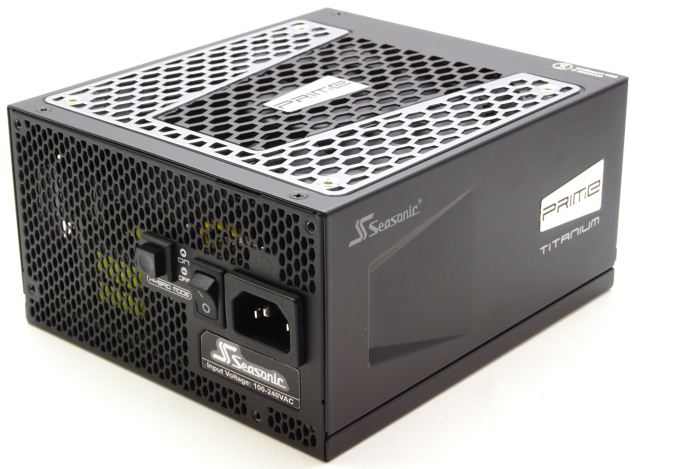The Seasonic PRIME Titanium PSU (650W, 750W, 850W) Review: Mythical Performance
by E. Fylladitakis on April 7, 2017 9:00 AM ESTConclusion
In this review we had a look at Seasonic’s latest top series, the PRIME Titanium 650W, 750W and 850W PSUs. They are not the most powerful models on the market designed for quad-GPU beats, but they are the technologically best units that Seasonic is currently offering to consumers.
It is slightly ironic to label these units as Seasonic’s “technological pinnacle”, because they are not using any of the latest “leading” topologies or technologies. As a matter of fact, their core topology is relatively common and simple; just a typical input bridge converter and APFC circuit, a resonant LLC full bridge on the primary with synchronous rectification on the secondary. It is a configuration that we have seen many times in the past, yet no other designer before Seasonic has ever reached such performance figures with it.
Seasonic made it easy for us to summarize the entirety of these units’ performance in just one word: mythical. The very high efficiency that easily broke the 80Plus Titanium certification requirements with 230V AC input was a small surprise at first, but surprise turned to shock when we began testing the units inside our hotbox. Not only the high ambient temperatures hardly shook the efficiency of the units, the power quality and voltage regulation figures were just incredible.

The AnandTech Recommended Award
For the Seasonic PRIME Titanium Series
Before testing these three units, we would not believe that such performance would be possible with a consumer-grade PC PSU.
In terms of quality, Seasonic did not hold back at all. We found only top-tier quality components in the PRIME Titanium PSUs, even down to the least significant elements of the design. The fact that the three units that we have tested display almost indistinguishable performance under the same load conditions suggests that there are no discrepancies due to component characteristics. Seasonic covers the PRIME Titanium units with a 12-year warranty, which is more than reassuring. The only small issue here is that the designer had to sacrifice some acoustics performance to ensure that the internal temperatures of the units will remain very low, even under very adverse operating conditions.
So perhaps the only real enemy of the new Seasonic PRIME Titanium series is their own retail price tag. Seasonic aims to be the best vendor with their OEM designs, and it all comes at a cost. With the 650W, 750W and 850W units retailing for $160, $175 and $200 respectively, many regular users will be satisfied with the performance of an “average” 80Plus Gold certified unit that will cost half as much, or even less. With all that being said, the retail price of these three units is not forbiddingly high - super high end PSUs reaching 1200W and above can come in at similar W/$.
But for these price tags, you get one of the most stunning PSU designs available today, combined with high efficiencies and a long warranty to back it up.












86 Comments
View All Comments
GhostOfAnand - Friday, April 7, 2017 - link
High-efficiency is only one perk. The superlative ripple, transient response, etc of these Seasonic units means you're providing your high-end components with quality power. This means longer life, better stability, and greater over-clocking headroom.A solid PSU is the cornerstone of a proper build done right.
Arbie - Friday, April 7, 2017 - link
Written like a true non-engineer.Kevin G - Friday, April 7, 2017 - link
The price difference would pay for itself in 7 years and considering that this unit has a 12 year warranty, the difference certainly would pay for itself. There are also additional factors to consider if say electrical prices increase. Return on investment would occur sooner under such a scenario.The real challenge is if motherboards continue to adhere to the ATX power spec for another decade. Using this power supply down the road could be challenge in that context. To these models credit, it is fully modular so if an ATX replacement were to arrive without adding any additional voltages (i.e. using only 3.3V, 5V and 12V), then an adapter cable could be created.
These are appear to be excellent units worth the price premium they command.
DanNeely - Friday, April 7, 2017 - link
It's not just the whole ATX standard, but all the stuff around it that would make me leery of planning on more than a half dozenish years from a PSU for deciding if the premium is worth it. We've been ATX for the last 20ish years during which time we've gone from 3.3/5V centric to mix low/high voltage centric, to 12V centric designs. Extra CPU power has gone from 6 pin 3.3/5V to a 4pin 12v to 8 pin 12v. Peripheral connectors have gradually gone from Molex to Sata. GPU power has gone from a 4pin Molex to 6pin to 8 pin. While an older PSU may work with suitable adapters (only the CPU connectors and 3.3/5 vs 12v centric designs are breakers); doing so becomes progressively more of a kludge.JasperJanssen - Saturday, April 8, 2017 - link
Yeah, but there's no reason whatsoever to think that we're going to move away from 12V centric any time soon, or ever. It's possible that we're going to drop legacy rails such as 3.3 and 5 like we did -5/-12 (already mostly gone), but I don't see us moving from 12V centric to 24V centric or 48V centric, even if that would give further efficiency advantages, and I don't think the 12-to-1.1V DC-DC converters are meaningfully less efficient than 24 or 48 to 1.1V -- so the possible gains are mostly in using less copper for the current carrying capacity. I don't see that as enough of a gain to overcome the inertia of the whole industry.Plus, the desktop PC industry is dying anyway, and when you're slowly dying is not usually the time to reinvent whole parts unless that can prevent the slowly dying.
Aslan7 - Monday, April 10, 2017 - link
A friend upgraded their qx6600 systen 3-4 years ago, and I got the guts (MB, CPU, RAM) of the old system. Another friend was retiring a Micron Millennia PIII system from ~1997. I was planning to use the qx6600 guts in the Micron Millennia case, but as I was looking at it, I would have needed a massive number of power adapters to be able to plug things in. I said fine, so what?, but then I looked at the 12V output on the PSU. I was short amps. It wasn't even worth buying the adapters to try it. I threw away the guts of the Micron Millennia including the PSU. In short it's going to be a rare 90's power supply that has enough 12V amps that it would be usable today even with adapters.The Micron Millennia case though, is very well designed. The fans clip in and swing out of the way on hinges, there's fans where they're needed. The drive arrangement is nice, the PSU is mounted on a hinge to make cable routing easier. There's plenty of drive bays. All the proper standoffs are there for a large motherboard. It's a really good case especially being from 1997. The only two issues were the power button quit working about 2 years ago, so I have a power button cable run between the side panel and the case, and the other issue was the standoffs for the motherboard are insanely long. I had to special order those so that I had enough to support my large motherboard.
I run a number of personal systems 24/7 doing various tasks for me and while idle performing computations for WorldCommunityGrid.org (curing cancer and such) My main system was powered by a PSU from ~2000. It was rated at 250 and I was pulling somewhere between an estimated 330 and 390 watts 24/7. It felt like it was spitting fire from the exhaust. To the credit of the Chinese no brand power supply it lasted for 16 months running 24/7. To replace that I bought an Enermax Platimax 80+platinum power supply, and about the same time I bought another 80+ platinum power supply for the qx6600. The energy savings have been noticeable with both, and they're cooler and quieter. Sorry, I don't have solid numbers to share,but I'm certain I've saved a large portion of their costs. The frustrating part is seeing reviews for 80+titanium power supplies at less than half the cost of some of the power supplies I bought.
I'm really glad 80+titanium power supplies are happening, but why now? What changed to make these possible? Couldn't these have been made back in 2000? Why weren't they? Or are things honestly that much better manufactured today?
SkipPerk - Wednesday, May 3, 2017 - link
I have often felt the same way, and I think it is just that now that prices have fallen so much, branding matters more. Also, the entire clear PC window case thing has people caring about aesthetics more.That said, modern PSU's are truly better than they have ever been. I am rocking and loving a Seasonic, and it is amazing just how good these new PSU's are. Your Platimax will likely last until the standards change.
HomeworldFound - Friday, April 7, 2017 - link
For a power supply that has a 12 year warranty, that saving is pretty good, it'll last that long. It usually costs me a lot more than that, I get all of my power supply cables individually sleeved.poohbear - Friday, April 7, 2017 - link
Nobody buys these for the savings, they buy it for the rock solid performance when all your components are overlooked to their limits!Gastec - Saturday, August 15, 2020 - link
I compensated by consuming less Kentuky Fried Bourbon for one year.